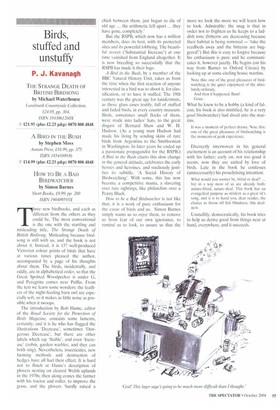Birds, stuffed and unstuffy
P. J. Kavanagh
THE STRANGE DEATH OF BRITISII BIRDSONG by Michael Waterhouse Landmark Counayside Collection, £24.95, pp. 304, ISBN 1843061260X £21.95 (plus £2.25 p&p) 0870 800 4848 A BIRD IN THE BUSH by Stephen Moss Aunan Press, £16.99, pp. 375 ISBN 1854109936 £14.99 (plus £2.25 p&p) 0870 800 4848
How TO BE A BAD BIRDWATCHER by Simon Barnes
Short Books, £9.99, pp. 200 ISBN 190409595X
Three new birdbooks, and each as different from the others as they could be. The most conventional is the one with the startling and misleading title, The Strange Death of British Birdsong. Misleading because birdsong is still with us, and the book is not about it. Instead, it is 137 well-produced Victorian colour prints of birds that have at various times pleased the author, accompanied by a page of his thoughts about them. The birds, incidentally, and oddly, are in alphabetical order, so that the Great Spotted Woodpecker is under G, and Peregrine comes near Puffin. From the text we learn some wonders: the feathers of the night-feeding barn owl are especially soft, so it makes as little noise as possible when it swoops.
The introduction by Rob Hume, editor of the Royal Society for the Protection of Birds Magazine, contains some laments, certainly; and it is he who has flagged the illustrations 'Decrease', sometimes 'Dangerous Decrease', hut there are other labels which say 'Stable', and even 'Increase' (robin, garden warbler, and they can both sing). Nevertheless, insecticides, new farming methods and destruction of hedges have all had their effect. It is hard not to flinch at Hume's description of plovers nesting on cleared Welsh uplands in the 1970s; then along comes the farmer with his tractor and roller, to improve the grass, and the plovers 'hardly raised a chick between them, just began to die of old age ... the arithmetic fell apart ... they have gone, completely.'
But the RSPB, which now has a million members, does its best, with its protected sites and its powerful lobbying. The beautiful avocet (`Substantial Increase') at one time vanished from England altogether. It is now breeding so successfully that the RSPB has made it their logo.
A Bird in the Bush, by a member of the BBC Natural History Unit, takes us from the time when the first reaction of anyone interested in a bird was to shoot it, for classification, or to have it stuffed. The 19th century was the great age for taxidermists, as those glass cases testify, full of stuffed and faded birds, in every country museum. Birds, sometimes small flocks of them, were made into ladies' hats, to the great disgust of Bernard Shaw and W. H. Hudson. (As a young man Hudson had made his living by sending skins of rare birds from Argentina to the Smithsonian in Washington. In later years he ended up a passionate propagandist for the RSPB.) A Bird in the Bush charts this slow change in the general attitude, celebrates the early heroes and heroines, and studiously justifies its subtitle, `A Social History of Bia'watching'. With some, this has now become a competitive mania, a slavering over rare sightings, like philatelists over a Penny Black.
How to he a Bad Birdwaicher is not like that; it is a work of pure enthusiasm for the cause of birds and us. Simon Barnes simply wants us to enjoy them, to remove us from fear of our own ignorance, to remind us to look, to assure us that the more we look the more we will learn how to look. Admirable: the snag is that in order not to frighten us he keeps to a laddish tone (bitterns are decreasing because their habitat is being removed — 'take the reeclbecls away and the bitterns are huggered!') But this is easy to forgive because his enthusiasm is pure and he communicates it, however jazzily. He begins (on his way from Barnet to Oxford Circus) by looking up at some circling house martins.
Note this: one of the great pleasures of birdwatching is the quiet enjoyment of the absolutely ordinary.
And then it happened. Barn!
Gone.
What he knew to be a hobby (a kind of falcon; his book is also mistitled, he is a very good birdwatcher) had dived into the martins.
It was a moment of perfect drama. Note this: one of the great pleasures of birdwatching is the moments of peak experience.
Discreetly interwoven in his general excitement is an account of his relationship with his father; early on, not too good it seems, now they are united by love of birds. Late in the book he confesses (unnecessarily) his proselytising intention:
What would you sooner he, blind or deaf? ... hut in a way most of us are already both: nature-blind, nature-deaf. This book has an evangelical purpose as strident as a great tit's song, and it is to hand you, dear reader, the chance to throw off this blindness, this deafness.
Unstuffily, democratically, his book tries to help us derive good from things near at hand, everywhere, and it succeeds.


















































































































 Previous page
Previous page